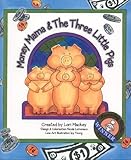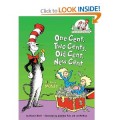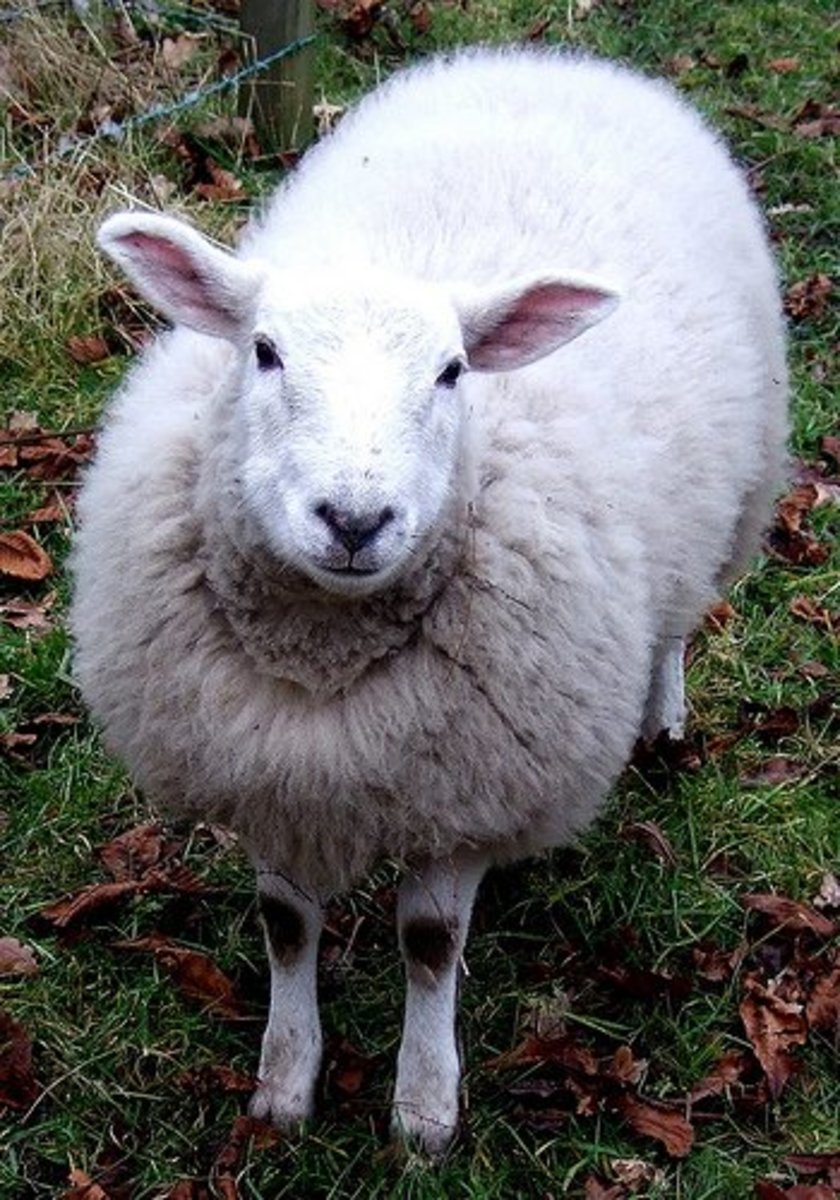Using a Piggy Bank to Teach Kids about Money

What is the best time to start using a piggy bank to teach kids about money? Can you start yesterday? Financial and parenting experts believe it is never too early to start teaching your kids about money. When a child learns to count, it is time for them to start their financial education. You don't need to give kids any money at this young age, but it helps to include them when talking about money, making budgets, planning for upcoming expenses and even comparison shopping. Remember to keep the learning age appropriate.
The best way to teach kids of any age about money is through the use of a piggy bank. With young kids, start by letting them take the change from your pocket and placing that in the piggy bank. For older kids, just the sight of money piling up in a piggy bank, coffee can or mason jar may provide a lesson about saving money.
Here are some tips for teaching kids about money at different stages in their development.
.
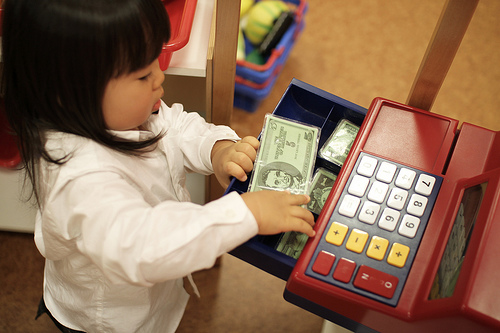
Preschool
Kids, even at this young age, can start learning about money by saving it in a piggy bank. It is important to realize that kids of this age need to hold, touch and get at the money easily. Even at this young age, kids somehow know that money provides a way of getting something that they want. They can make decisions to buy things with the money they have saved but be sure to limit their choices to just a few things. Don't make it complicated, keep it simple at this age.
.
Elementary School
At this age, kids know what money is but may have not yet figured out the denominations of each coin or bill. Teaching kids about money at this age is critical because this is when kids start imitating your spending habits. It's vital that you watch your own spending habits and provide teaching moments that show concrete examples of how money is to be used. This is also the age at which they understand about saving money over a short period of time to purchase a particular item. A piggy bank is the perfect tool for this purpose.
.

Middle School
If you have kids this age, you know that the pressure to spend is a huge part of the pre-teen's world. Even worse, all the other pre-teens at school are also feeling the urge to spend. Peer pressure becomes a huge influence on what they buy because they are trying to gain the approval of their peers by what they buy. It's SO important that you teach your kids to save at this point in their lives. At this age, kids realize they can work or get a job and actually earn money. This is also the time that they need to understand more about giving money away and saving money.
.
Teenagers and Money
This is a tough age for kids and money, especially if they haven't learned about money until now. They yearn for financial independence and are resistant to being told what to do with money. Money may become a way to help them resolve their insecurities of feel better about themselves. This is the time in their financial lives that they need the loving but firm guidance of parents more than ever.

At this age, they may want to borrow money and even start using a credit card. Be warned, this type of spending can lead to bigger problems. If they do make a mistake, it may be best to let them learn the hard lessons about money. Bailing them out of a tough money situation like a bounced check or spending over the limit on a credit card is not advisable. Instead, help them to fins their own way out of the financial bind - assistance in finding a job, or additional job. Perhaps doing odd jobs around the house to earn extra cash to pay those bills.
Even at this age it is not too late to use a piggy bank - or an actual bank - to help them learn about saving money, establishing long-term goals and staying within the limits of their spending. Kids at this age need to learn that they can become financially independent id they know how to handle money properly.
_________________________________________________________________
Top 5 Tips for Using a Piggy Bank to Teach Kids About Money
.
1) Teach Kids at Any Age That Money is Real
When it comes to the subject of money, kids may tend to make light of it., especially younger kids who may not fully understand the concept of money. Play money and real money are really the same to kids at this age. It's important when playing with money that kids realize money is real and has real power. I know money tends to be dirty and the thought of a child placing money or their hands after handling money into their mouths is terrifying to some parents. That's why it's important you closely supervise kids when "playing" with real money.
.
2) Get Children involved with Money
A piggy bank is perfect for getting kids involved with money. Other ways you can get them involved is helping you to clip coupons, letting them add up money for payment of a few items or having them receive change from a purchase and watching the clerk count out the change. When shopping, let them use a calculator and try to add up certain items in the shopping cart. All of these activities provide situations in which kids learn more about money.
.
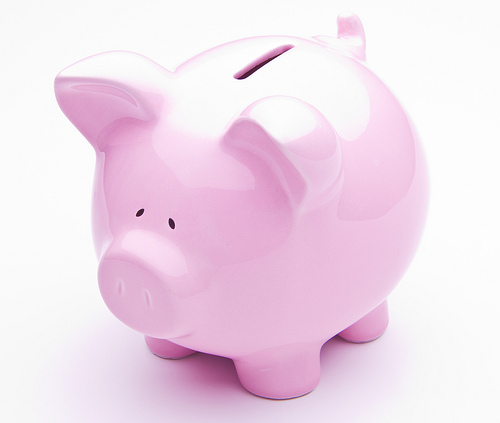
3) Use a Piggy Bank
This doesn't have to be a formal style "Piggy Bank" like you see in a store, but that can help to make saving money more interesting for your child. You can use a clear jar or a coffee can. A clear piggy bank is best because it allows the kids to see their money and how it is growing each time they add a bit. One thing my kids loved was taking a hammer and busting open that ceramic piggy bank and watching all that money come pouring out - just be careful of any sharp edges! If you have a glass piggy bank, breaking it open is NOT advisable!
.
4) Teach them about the value of money
Some of the best lessons about money and spending have been taught to my own children in thrift stores. When my own kids were younger, they didn't give much thought to what items cost. When they got a little older, found job and had to spend their own saved money to buy things, money suddenly developed a new meaning in their lives. Now, they shop at the retail stores to see what they like and scour the aisles of thrift stores to make their purchases. I can say they have learned the value of money.
.
5) Teach them How to Earn Money and Plan for it's Use
Let's face it, kids don't naturally know how to save money - somebody has to teach them. Guess what, if you are the parent then that responsibility falls to you. The absolute best way to teach any child of any age is to use a piggy bank or something like a coffee can or mason jar. There is nothing more satisfying than picking up that piggy bank or container and hearing the jingle of heaping piles of cash and coins rattling around inside.
This old animated cartoon was favorite of mine many, many years ago. As a child, we typically watched cartoons on Saturday mornings. Some genius (I mean that sincerely) came up with an idea to help educate kids through cartoons - and Schoolhouse Rock was born. The one posted here teaches kids about saving money for something desired in the future. Watching this one brought back many good memories about saving money to buy things I wanted.
.
_________________________________________________________________
_________________________________________________________________

BOOK REVIEW: Money Mama and the Three Little Pigs
If you want to start teaching your kids about money and finance from a very early age, this is the book to start their financial education. Created by author Lori Mackey, this book was intended to be read aloud with Kids age 4 years and older. The 48-page book teaches the plain facts about money management in a way young minds will easily understand and also helps your kids to develop a positive attitude about money. The fun illustrations will keep young children engaged and interested while you teach them about:
• saving money
• spending money wisely
• the value of giving money away
• investing money
• putting aside money for a rainy day
The author believes that the basic concepts of money can be taught to children even before they actually know anything about money. Research proves that kids learn best through the modes of play and hands-on experience. This book was designed to get kids involved with money directly.
This Book Has Been Reviewed on NBC's TODAY Show...
In the book, Lori Mackey teaches the 10/10/10/70 concept about money. This concept teaches kids that for every dollar they bring in, they give 10% to charity, invest 10%, save 10% and spend the remaining 70% for the things they need and want. One part of that hands-on learning experience is the Money Mama Piggy Bank(™). This special piggy bank is divided into four compartments which make it very easy for young children to divide their money using the 10/10/10/70 concept.
Those who have bought and used this book give it very high praise indeed. One mother wrote about her own bad money habits that she had learned from her own parents, which they learned from their parents. This mother saw what this was doing to her family and she wanted to break this destructive cycle for her kids. She gives the book "two thumbs up" and recommends it for any parent whop wants to teach their children how to successfully handle money.
_________________________________________________________________
- Six Banks That Can Help Teach Kids Money Management Skills
This debt blog will detail and chronicle the transformation of my personal financial life, including the repayment of tons of credit card debt, the establishment of a workable budget, building of an emergency fund and saving for retirement. In additi - Money Savvy Generation | Money Savvy Pig
Good tips on how to help kids learn to save money
_________________________________________________________________
More Resources to Use a Piggy Bank to Teach Kids About Money...
_________________________________________________________________

